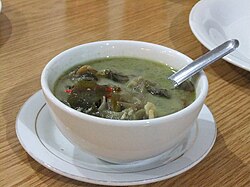Sayur lodeh
 |
|
| Type | Soup |
|---|---|
| Course | Main |
| Place of origin | Indonesia |
| Region or state | Java |
| Created by | Javanese |
| Serving temperature | Hot or room temperature |
| Main ingredients | Coconut milk, vegetables (jackfruit, eggplant, chayote, melinjo, long beans, tofu, tempeh), or |
| |
|
Sayur lodeh is a soup prepared from vegetables in coconut milk popular in Indonesia, but most often associated with Javanese cuisine.
Common ingredients are young unripe jackfruit, eggplant, chayote, melinjo beans and leaves, long beans, green chili pepper, tofu and tempeh, cooked in coconut milk and sometimes enriched with or . The bumbu spice mixture includes ground chili pepper (optional, depending on the desired degree of spiciness), shallot, garlic, candlenut, coriander, kencur powder, turmeric powder (optional), dried shrimp paste, salt and sugar. The greenish white sayur lodeh is made without turmeric, while the golden one has turmeric. Sometimes green stink beans are added.
The ingredients of sayur lodeh are similar to sayur asem, with the main difference in its liquid portion, sayur lodeh is coconut-milk based while sayur asem is tamarind based. To add aroma and taste, an authentic Javanese sayur lodeh recipe might include ground old tempeh. This old tempeh is known as "yesterday's tempeh" or "rotten tempeh" (Javanese: tempe bosok).
The origin of the dish can be traced to the Javanese people's tradition of Java. According to Javanese Kejawen beliefs, sayur lodeh is an essential part of the slametan ceremony and it is believed as tolak bala, to ward off possible danger and disaster. The people and the Keraton (court) of Yogyakarta often communally cook sayur lodeh for the slametan ceremony. It is believed this can deter disasters such as wind storm, earthquake, volcanic eruption, drought and plague. It is well known in Javanese cuisine and has spread throughout Indonesia and the region. Because of Javanese migration to neighboring countries, today sayur lodeh is also popular in Malaysia and Singapore.
...
Wikipedia
